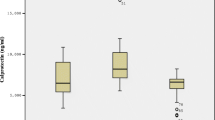Abstract
Aims and Background
The oxidation of protein plays an essential role in the pathogenesis of an important number of degenerative and cancer diseases, which is now widely recognized. The aim is to examine advanced oxidation protein products (AOPPs), lipid peroxidation products malondialdehyde (MDA), and ferrous oxidation in xylenol orange (FOX) in blood samples of papillary thyroid cancer patients compared with healthy controls to determine the oxidation status and the change after thyroidectomy.
Methods
Thirty-five female thyroid cancer patients who underwent total thyroidectomy and 39 female control subjects were included into this study. Prethyroidectomy and postthyroidectomy, AOPP, FOX, and MDA levels were studied.
Results
Prethyroidectomy AOPP, FOX, and MDA levels were significantly higher compared to control (P < .05). In postthyroidectomy AOPP, FOX, and MDA levels were significantly decreased compared with prethyroidectomy levels (P < .05). However, postthyroidectomy levels on the 20th day were still significantly higher, compared to control subjects (P < .05).
Conclusion
In conclusion, all of AOPP, FOX, and MDA levels that are markers of protein oxidation and lipid hyperoxidation may induce thyroid cancer development and begin to decrease after thyroidectomy.
Similar content being viewed by others
References
Berlett BS, Stadtman ER. Protein oxidation in aging, disease and oxidative stress. J. Biol. Chem. 1997; 272:20313–6
Stadtman ER, Berlett BS. Reactive oxygen-mediated protein oxidation in aging and disease. Drug Metab Rev 1998; 30:225–43
Witko-Sarsat V, Friedlander M, Capeller-Blandin C, et al. AOPP as novel marker of oxidative stress in uremia. Kidney Int 1996; 49:1304–13
Cheeseman KH, Slater TF. An introduction to free radical biochemistry. British Med. Bull. 1993; 49:481–93
Loeckie LZ, Meerman JHN, Commandeur JNM. Biomarkers of free radical damage: applications in experimental animals and in humans. Free Radic Biol Med 1999; 26:202–6
Zadeh-Nourooz J, Tajaddini-Sarmadi J, Wolff S. Measurement of plasma hydroperoxide concentrations by the ferrous oxidation-xylenol orange assay in conjunction with triphenylphosphine. Anal Biochem 1994; 220:403–9
Apps DK, Cohen BB, Steel CM. Amino acid metabolism. Biochemistry: A Concise Text for Medical Students, 5th ed. London: Bailliere Tindall; 1992;176–7
Dumitrescu C, Belgun M, Olinescu R, et al. Effect of vitamin C administration on the ratio between the pro and antioxidative factors. Rom J Endocrinol 1993; 31(1-2):81–4
Lenzen S, Drinkgern J, Tiedege M. Low antioxidant enzyme gene expression in pancreatic islets compared with various other mouse tissue. Free Rad. Biol Med 1996; 20:463–6
Mano T, Shinohara R, Iwase K, et al. Changes in free radical scavengers and lipid peroxide in thyroid glands of various thyroid disorders. Horm Metab Res 1997; 29(7):351–4
Sadani GR, Nadkarni GD. Role of tissue antioxidant defence in thyroid cancers. Cancer Lett 1996; 109(1–2):231–5
Halliwell B, Clement MV, Long LH, et al. Hydrogen peroxide in the human body. FEBS Lett 2000; 486:10–3
Wolf SP. Ferrous ion oxidation in presence of xylenol orange for measurement of hydroperoxides. Methods Enzymol 1984; 223:182–9
Droge W. Free radicals in the physiological control of cell function Physiol Rev 2002; 82:47–95
Alderman Ch J, Shah S, Foreman JC. The role of advanced oxidation protein products in regulation of dendritic cell function. Free Radical Biol Med 2002; 32:377–385
Loeckie LZ, Meerman JHN, Commandeur JNM. Biomarkers of free radical damage: applications in experimental animals and in humans. Free Radic Biol Med 1999; 26:202–26
Author information
Authors and Affiliations
Corresponding author
Additional information
This study was presented in Clinical Biochemistry Congress at November 1–4,2006.
Rights and permissions
About this article
Cite this article
Kosova, F., Çetin, B., Akıncı, M. et al. Advanced Oxidation Protein Products, Ferrous Oxidation in Xylenol Orange, and Malondialdehyde Levels in Thyroid Cancer. Ann Surg Oncol 14, 2616–2620 (2007). https://doi.org/10.1245/s10434-007-9425-5
Received:
Accepted:
Published:
Issue Date:
DOI: https://doi.org/10.1245/s10434-007-9425-5




